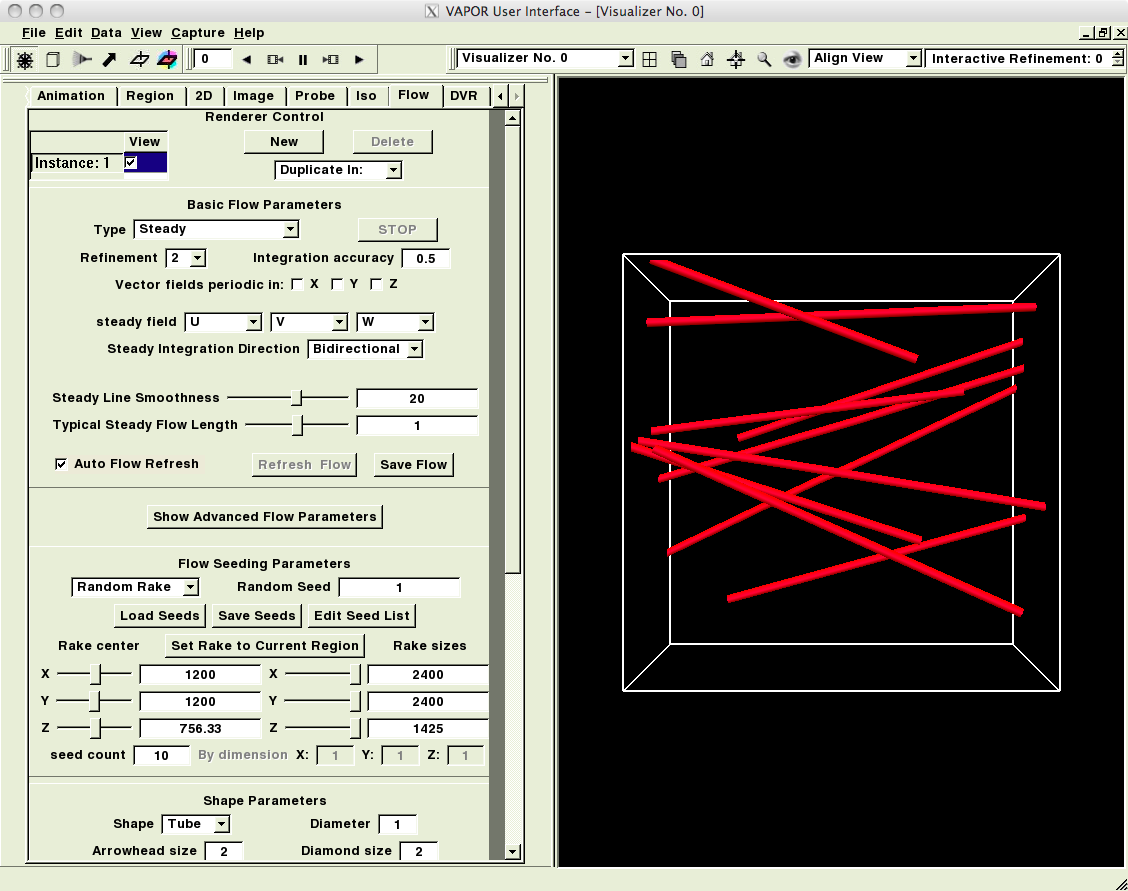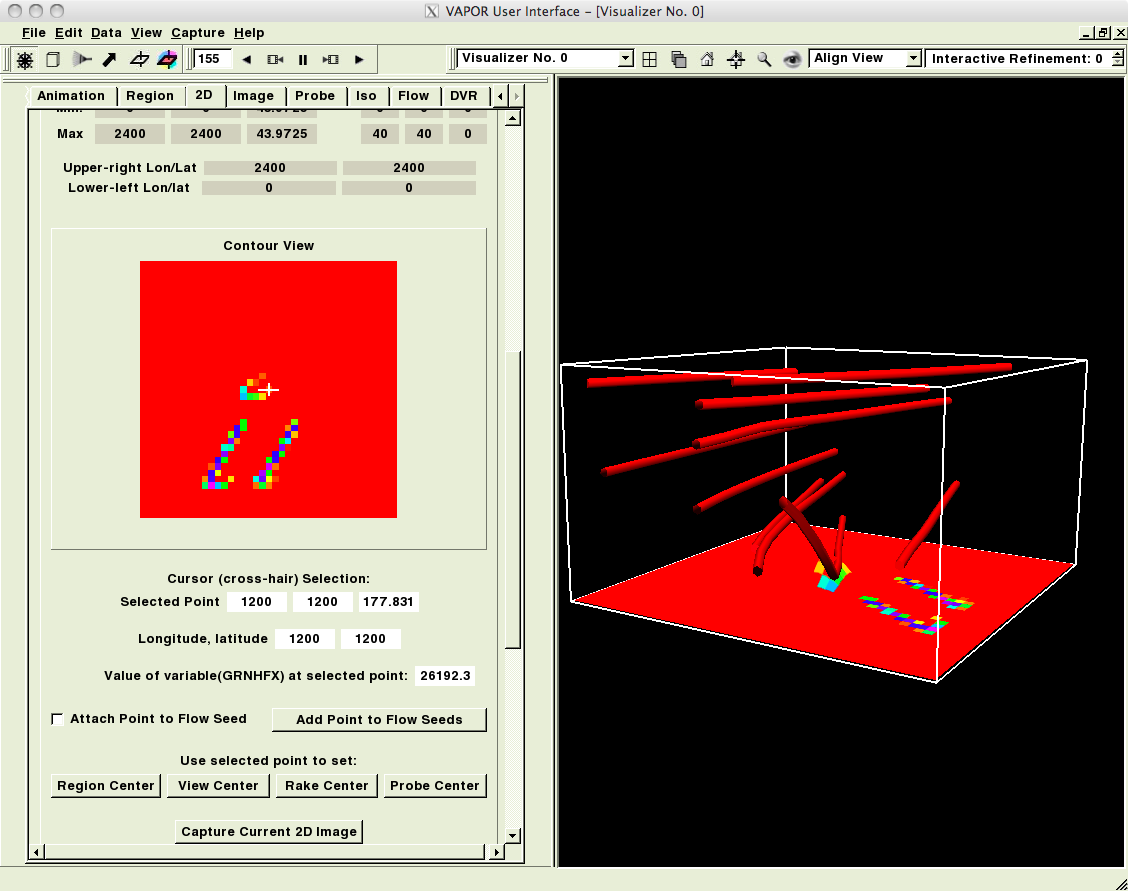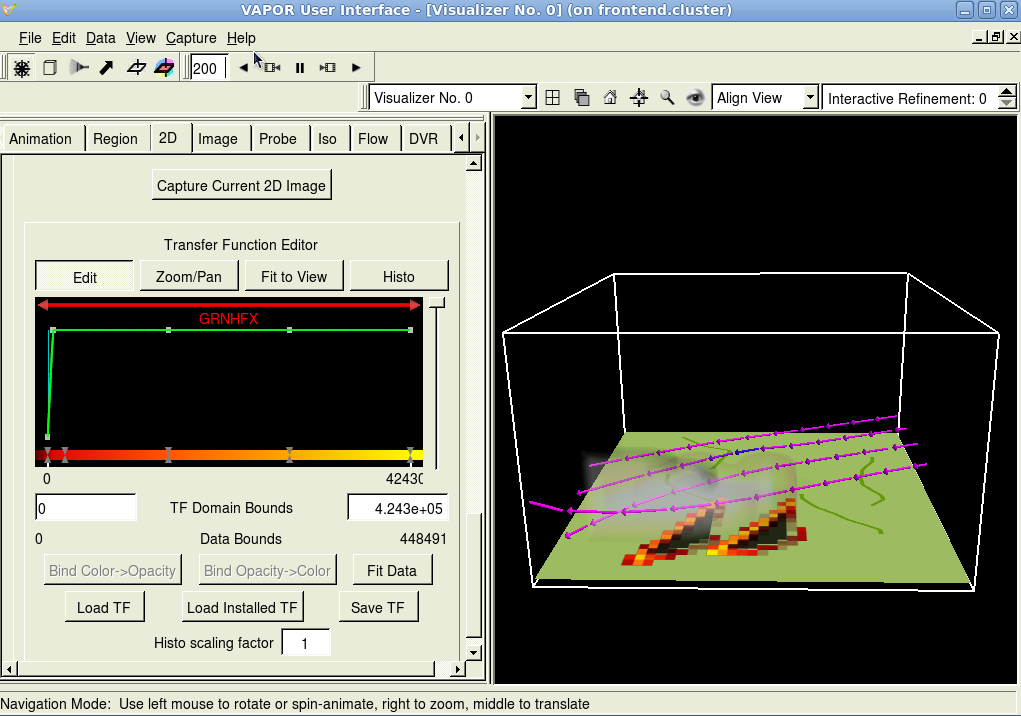Difference between revisions of "How to visualize WRF-Fire output in VAPOR"
| Line 51: | Line 51: | ||
* If you have a tiff image of the terrain click on the "Image" tab. If the the Image is not a geotiff (or you are not sure) uncheck "Georeference", then "Select Image File" and navigate to your file. Finally check "Apply image to terrain" and "Instance: 1". After the image is displayed you may also check "Crop to bounds" if needed. | * If you have a tiff image of the terrain click on the "Image" tab. If the the Image is not a geotiff (or you are not sure) uncheck "Georeference", then "Select Image File" and navigate to your file. Finally check "Apply image to terrain" and "Instance: 1". After the image is displayed you may also check "Crop to bounds" if needed. | ||
* Click the "Animation" tab and move the "Frame position" slider to a time when you know that the fire has already well developed. | * Click the "Animation" tab and move the "Frame position" slider to a time when you know that the fire has already well developed. | ||
| − | * Click the "2D" tab, select | + | * Click the "2D" tab, select variable GRNHFX, check "Refinement" 2, and "Apply color and opacity to terrain surface", At the bottom of the tab set the colormap and opacity as, e.g., in the following picture (the opacity is sharply cut off near zeros values and set full elsewhere, so that the areas not on fire are fully transparent): |
| − | * Click the "Flow" tab, | + | [[File:Vapor-fire-colormap-window.png|600px]] |
| + | |||
| + | If there is a *.vtf file available for the colormap and opacity, click "Load TF" and navigate to the file. Finally, check "Instance: 1". You should see the fire area on the terrain. One might also check that the "Z-center" coordinate has a slightly higher value in the "2D" tab than in the "Image" tab, i.e., that the fire will be displayed 'on top of the terrain'. | ||
| + | * On top of the "2D" tab under "Renderer Control" click "New" push "Instance: 2" and select the AVG_FUEL_FRAC variable, check "Refinement" 2, and "Apply color and opacity to terrain surface". Scroll down to "Transfer Function Editor", click "Load Installed TF" and select '''grayscale.vtf'''. The settings for opacity are illustrated by the picture below (the opacity is high and color is dark for regions with little fuel remaining): | ||
| + | Note that this variable might not be convenient if there are areas in the region that do not contain any fuel a-priori. | ||
| + | * Click the "Flow" tab, make sure that the "steady field" variables are U, V, W and select "Refinement" 2. Scroll down to "Flow Seeding Parameters", select "Nonrandom Rake" and "seed count ... By dimension" to ,e.g., 3, 3, 1. In the "Shape parameters" area set "shape" to arrows, decrease "Diameter" to e.g., 0.5 and in "Color/Opacity mapping" area set "Color" to "Position along flow". Check the box "Instance: 1". If there is a warning about flow lines below zero click "OK", but follow the instructions: in "Edit" top menu select "Edit Visualizer Features" and in the "Variable values outside grid" uncheck for U,V and W the "Extend, down" box so that the "Below" appears in white with 0 value in the box. Hit "Apply" and "OK". | ||
==Works with== | ==Works with== | ||
Revision as of 04:38, 3 September 2010
Prerequistes
- A working installation of WRF-Fire, possibly on a remote supercomputer or a cluster.
- A visualization computer with a decent graphics card and drivers (hardware accelerated OpenGL required), 3 button mouse.
- Download and install VAPOR
- Read Getting started with VAPOR first.
- On a Mac, run the installation package, then add to your path /Applications/VAPOR.app/Contents/MacOS
- Do the exercises in the first few pages of the VAPOR quick start guide to learn the basics of the controls.
- VAPOR can be used remotely over a version of VNC with OpenGL support, to avoid transferring huge datasets to your visualization computer.
Directions
- Change in namelist.input the line with history_interval to the desired frame interval in seconds, for example history_interval_s=1. Make sure frames_per_outfile is large enough so that only one wrfout file is produced.
- Run WRF-Fire. The pictures below are from the "hill" ideal run in WRF-Fire.
- If the visualization computer is different from the computer where you run WRF-Fire, transfer the wrfout file to the visualization computer
- Convert the wrfout file for use with VAPOR: run from the command line
- wrfvdfcreate yourwrfoutfile yourwdffile.vdf
- wrf2vdf yourwdffile.vdf yourwrfoutfile
- Start VAPOR by clicking on its icon or vaporgui from the command line
- In the GUI, click "Data" on the top menu bar, then "load dataset in the current session", and navigate to the yourwdffile.vdf you have just created. In the black right panel, you should see an empty wireframe box from the top.
- Click the "Flow" tab, check the box "Instance 1", click "OK" on a warning about flow lines below zero. Select "Refinement" 2. You should see a picture like this (the starting points of the flow lines are picked randomly so they are different in every session):
- Click the "Animation" tab and move the "Frame position" slider to the middle (in the ideal "hill" example), or to a time when you know that the fire has already well developed. The flowlines should move a little.
- Click the "2D" tab, check "Instance 1", select "Refinement" 2, and 2D variable GRNHFX, check "Apply color and opacity to terrain surface", and push the "Fit data" button at the bottom.
- Rotate the image with a mouse to see something like this:
- Click on the "Animation" tab, click on the rewind and play VCR controls, and watch the movie. If the movie is too slow, go back to the "Flow" tab and reduce the "Refinement" value.
- To capture the movie, use "Capture", "Begin image capture sequence in visualizer 0", select directory, then run the movie, when done "Capture" "End image capture sequence". You get the movie frames as jpg files.
- Use the DVR tab and other VAPOR features for a more advanced visualization as desired.
More advanced visualization
- Optional: If you plan to work with large files (over 2GB), recompile NetCDF as: first export WRFIO_NCD_LARGE_FILE_SUPPORT=1 and then run
./configure --disable-netcdf4 --disable-dap --enable-large-file-tests --prefix=the contents of your NETCDF variable
Note the "--enable-large-file-tests" switch and remeber that nco should also reflect this. On a Mac install nco simply as
sudo port update nco
- If the wrfout file contains all WRF variables, we need to select the desired variables: U,V,W for wind streamlines, GRNHFX for fire, QVAPOR for smoke and AVG_FUEL_FRAC for the burned area.
The selection of variables (if wrfout contains more variables than needed) can be done in two ways:
- create new NetCDF file with this variables by ("-O" switch overrides the file and if Times is not available, do not use it)
ncks -v U,V,W,QVAPOR,GRNHFX,AVG_FUEL_FRAC,PH,PHB,Times wrfout -O file wrfvdfcreate file file.vdf wrf2vdf file.vdf file
The wrfvdfcreate command creates a vdf metafile with a description of the data for Vapor and wrf2vdf created a directory file_data with the actual data.
- the other option is to specify the variables in the wrfvdfcreate call, i.e., run
wrfvdfcreate -vars3d U:V:W:QVAPOR -vars2d GRNHFX:AVG_FUEL_FRAC wrfout file.vdf wrf2vdf file.vdf wrfout
This would create a directory wrfout_data with the same content as the directory file_data above.
- Start VAPOR by clicking on its icon or vaporgui from the command line.
- If you are provided a "Vapor saved session file" *.vss click "File" in the top menu bar and load this file by "Open session" dialogue. In either case, click "Data" in the top menu bar, then "load dataset in the current session", and navigate to the file.vdf (you might have just created). In the black right panel, you should see an empty wireframe box.
- If you have a tiff image of the terrain click on the "Image" tab. If the the Image is not a geotiff (or you are not sure) uncheck "Georeference", then "Select Image File" and navigate to your file. Finally check "Apply image to terrain" and "Instance: 1". After the image is displayed you may also check "Crop to bounds" if needed.
- Click the "Animation" tab and move the "Frame position" slider to a time when you know that the fire has already well developed.
- Click the "2D" tab, select variable GRNHFX, check "Refinement" 2, and "Apply color and opacity to terrain surface", At the bottom of the tab set the colormap and opacity as, e.g., in the following picture (the opacity is sharply cut off near zeros values and set full elsewhere, so that the areas not on fire are fully transparent):
If there is a *.vtf file available for the colormap and opacity, click "Load TF" and navigate to the file. Finally, check "Instance: 1". You should see the fire area on the terrain. One might also check that the "Z-center" coordinate has a slightly higher value in the "2D" tab than in the "Image" tab, i.e., that the fire will be displayed 'on top of the terrain'.
- On top of the "2D" tab under "Renderer Control" click "New" push "Instance: 2" and select the AVG_FUEL_FRAC variable, check "Refinement" 2, and "Apply color and opacity to terrain surface". Scroll down to "Transfer Function Editor", click "Load Installed TF" and select grayscale.vtf. The settings for opacity are illustrated by the picture below (the opacity is high and color is dark for regions with little fuel remaining):
Note that this variable might not be convenient if there are areas in the region that do not contain any fuel a-priori.
- Click the "Flow" tab, make sure that the "steady field" variables are U, V, W and select "Refinement" 2. Scroll down to "Flow Seeding Parameters", select "Nonrandom Rake" and "seed count ... By dimension" to ,e.g., 3, 3, 1. In the "Shape parameters" area set "shape" to arrows, decrease "Diameter" to e.g., 0.5 and in "Color/Opacity mapping" area set "Color" to "Position along flow". Check the box "Instance: 1". If there is a warning about flow lines below zero click "OK", but follow the instructions: in "Edit" top menu select "Edit Visualizer Features" and in the "Variable values outside grid" uncheck for U,V and W the "Extend, down" box so that the "Below" appears in white with 0 value in the box. Hit "Apply" and "OK".
Works with
- WRF-Fire May 26 2010 and hopefully later
- VAPOR 1.5.2 and hopefully later
- Tested on MacBook Pro 4GB OS X 10.6 GeForce 8600M GT 512MB


